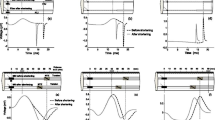Abstract
The present study investigated the possibility of using exponentially rising waveforms for selectively activating small motor fibres in a nerve bundle enclosed by a cuff electrode. Exponentially rising waveforms were studied using models of motor fibres and a volume conductor model. With an exponentially rising waveform (duration: 2 ms, time constant: 1 ms) large (15.5 μm) and small (8 μm) nerve fibres located at the edge of the nerve bundle had a current threshold of 125 μA and 53 μA, respectively. These reversals in the recruitment order of large and small nerve fibres located at the edge of the nerve bundle were observed for exponentially rising waveforms of 2, 4, and 6 ms in duration with time constants of 0.9, 0.6 and 0.6 ms, respectively. Reversals of the same nerve fibres located at the centre of the nerve bundle were observed for exponentially rising waveforms of 4 and 6 ms in duration, with a time constant of 0.6 ms for both waveforms. The underlying mechanism for selective activation of small nerve fibres with exponentially rising waveforms was found to be a combination of a decrease in the size of the local excitations in the centre node due to sodium channel inactivation and blocking of action potentials in large nerve fibres due to their larger difference in the membrane potential of adjacent nodes. The exponentially rising waveforms were compared with both rectangular prepulses and ramp prepulses. The rectangular prepulses were found to be unable selectively to activate small nerve fibres with the volume conductor model and criteria used in the present study, whereas the ramp prepulses performed as well as the exponentially rising waveforms. In conclusion, a novel stimulation paradigm has been proposed that may provide smooth, gradual control of muscle force with minimum fatigue.
Similar content being viewed by others
References
Accornero, N., Bini, G., Lenzi, G.L., andManfredi, M. (1977): ‘Selective activation of peripheral nerve fibre groups of different diameter by triangular shaped stimulus pulses’,J. Physiol.,273, pp. 539–560
Baratta, R., Ichie, M., Hwang, S.K., andSolomonow, M. (1989): ‘Orderly stimulation of skeletal muscle motor units with tripolar nerve cuff electrode’,IEEE Trans. Biomed. Eng.,36, pp. 836–843
Blair, E., andErlanger, J. (1933): ‘A comparison of the characteristics of axons through their individual electrical responces’,Am. J. Physiol.,106, pp. 524–564
Chiu, S. Y., Ritchie, J. M., Rogart, R. B., andStagg, D. (1979): ‘A quantitative description of membrane currents in rabbit myelinated nerve’,J. Physiol.,292, pp. 149–166
Deurloo, K. E., Holsheimer, J., andBergveld, P. (2001): ‘The effect of subthreshold prepulses on the recruitment order in a nerve trunk analyzed in a simple and a realistic volume conductor model’,Biol. Cybern.,85, pp. 281–291
Dumitru, D. (1994): ‘Electrodiagnostic medicine’, (Yeong Mun Publishing Company, 1994)
Fang, Z. P., andMortimer, J. T. (1991a): ‘A method to effect physiological recruitment order in electrically activated muscle’,IEEE Trans. Biomed. Eng.,38, pp. 175–179
Fang, Z. P., andMortimer, J. T. (1991b): ‘Selective activation of small motor axons by quasi-trapezoidal current pulses’,IEEE Trans. Biomed. Eng.,38, pp. 168–174
Frankenhauser, B., andHuxley, A. F. (1964): ‘The action potential in the myelinated nerve fibre of xenopus laevis as computed on the basis of voltage clamp data’,J. Physiol.,171, pp. 302–315
Grill, W. M., andMortimer, J. T. (1997): ‘Inversion of the current-distance relationship by transient depolarization’,IEEE Trans. Biomed. Eng.,44, pp. 1–9
Henneman, E. (1981): ‘Recruitment of motorneurons: the size principle’,Prog. Clin. Neurophysiol.,9, pp. 26–60
Kennings, K., Andersen, O. K., Struijk, J. J., andArendt-Nielsen, L. (2002): ‘Modeling selective activation of thin nerve fibers using exponentially rising waveforms’. 7th Ann. Conf. International Functional Electrical Stimulation Society
Kugelberg, E., andSkoglund, C. R. (1946): ‘Natural and artificial activation of motor units — A comparison’,J. Neurophysiol.,9, pp. 399–412
McNeal, D. R. (1976): ‘Analysis of a model for excitation of myelinated nerve’,IEEE Trans. Biomed. Eng.,23, pp. 329–337
Nilsson, I., andBerthold, C. H. (1988): ‘Axon classes and internodal growth in the ventral spinal root L7 of adult and developing cats’,J. Anat.,156, pp. 71–96
Rijkhoff, N. J., Holsheimer, J., Koldewijn, E. L., Struijk, J. J., van Kerrebroeck, P. E., Debruyne, F. M., andWijkstra, H. (1994): ‘Selective stimulation of sacral nerve roots for bladder control: a study by computer modeling’,IEEE Trans. Biomed. Eng.,41, pp. 413–424
Rijkhoff, N. J., Holsheimer, J., Debruyne, F. M., andWijkstra, H. (1995): ‘Modelling selective activation of small myelinated nerve fibres using a monopolar point electrode’,Med. Biol. Eng. Comput.,33, pp. 762–768
Sassen, M., andZimmermann, M. (1973): ‘Differential blocking of myelinated nerve fibres by transient depolarization’,Pflugers Arch.,341, pp. 179–195
Solomonow, M. (1984): ‘External control of the neuromuscular system’,IEEE Trans. Biomed. Eng.,31, pp. 752–763
Sweeney, J. D., Mortimer, J. T., andDurand, D. (1987): ‘Modeling of mammalian myelinated nerve for functional neuromuscular stimulation’, IEEE/9th Ann. Conf. Eng. Med. Biol. Soc., Boston, pp. 1577–1578
Tanner, J. A. (1962): ‘Reversible blocking of nerve conduction by alternating-current excitation’,Nature,195, pp. 712–713
Trenchard, D., andWiddicombe, J. G. (1973): ‘Assessment of differential block of conduction by direct current applied to the cervical vagus nerve’,Acta Neurobiol. Exp. (Warsz.),33, pp. 89–96
Vuckovic, A., Rijkhoff, N. J., andStruijk, J. J. (2004): ‘Different pulse shapes to obtain small fiber selective activation by anodal blocking — a simulation study’,IEEE Trans. Biomed. Eng.,51, pp. 698–706
Wesselink, W. A., Holsheimer, J., andBoom, H. B. (1999): ‘A model of the electrical behaviour of myelinated sensory nerve fibres based on human data’,Med. Biol. Eng. Comput.,37, pp. 228–235
Zimmermann, M. (1968): ‘Selective activation of C-fibres’,Pflug. Arch. Gesamte Physiol. Menschen Tiere,301, pp. 329–333
Author information
Authors and Affiliations
Corresponding author
Rights and permissions
About this article
Cite this article
Hennings, K., Arendt-Nielsen, L., Christensen, S.S. et al. Selective activation of small-diameter motor fibres using exponentially rising waveforms: A theoretical study. Med. Biol. Eng. Comput. 43, 493–500 (2005). https://doi.org/10.1007/BF02344731
Received:
Accepted:
Issue Date:
DOI: https://doi.org/10.1007/BF02344731




